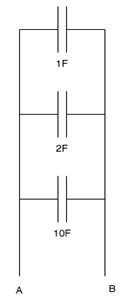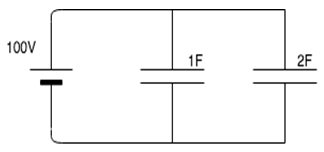This set of Basic Electrical Engineering Multiple Choice Questions & Answers (MCQs) focuses on “Capacitors in Parallel”.
1. What is the total capacitance when three capacitors, C1, C2 and C3 are connected in parallel?
a) C1/(C2+C3)
b) C1+C2+C3
c) C2/(C1+C3)
d) 1/C1+1/C2+1/C3
View Answer
Explanation: When capacitors are connected in parallel, the total capacitance is equal to the sum of the capacitance of each of the capacitors. Hence Ctotal=C1+C2+C3.
2. Calculate the total capacitance.

a) 10F
b) 15F
c) 13F
d) 20F
View Answer
Explanation: The equivalent capacitance when capacitors are connected in parallel is the sum of all the capacitors = 1+2+10 = 13F.
3. Calculate the voltage across AB if the total charge stored in the combination is 13C.

a) 1V
b) 2V
c) 3V
d) 4V
View Answer
Explanation: The equivalent capacitance when capacitors are connected in parallel is the sum of all the capacitors = 1+2+10 = 13F. V = Q/C = 13/13 = 1V.
4. Calculate the charge in the 2F capacitor.

a) 200C
b) 100C
c) 300C
d) 400C
View Answer
Explanation: Since the capacitors are connected in parallel, the voltage across each is the same, it does not get divided. Q = CV = 2*100 = 200C.
5. Calculate the charge in the 1F capacitor.

a) 200C
b) 100C
c) 300C
d) 400C
View Answer
Explanation: Since the capacitors are connected in parallel, the voltage across each is the same, it does not get divided. Q = CV = 1*100 = 100C.
6. Calculate the total charge of the system.

a) 200C
b) 100C
c) 300C
d) 400C
View Answer
Explanation: The equivalent capacitance when capacitors are connected in parallel is the sum of all the capacitors=1+2=3F. Q = CV = 3*100 = 300V.
7. When capacitors are connected in parallel, the total capacitance is always __________ the individual capacitance values.
a) Greater than
b) Less than
c) Equal to
d) Cannot be determined
View Answer
Explanation: When capacitors are connected in parallel, the total capacitance is equal to the sum of the capacitance of each of the capacitors. Hence Ctotal=C1+C2+C3. Since it is the sum of all the capacitance values, the total capacitance is greater the individual capacitance values.
8. When capacitors are connected in parallel, what happens to the effective plate area?
a) Increases
b) Decreases
c) Remains the same
d) Becomes zero
View Answer
Explanation: When capacitors are connected in parallel, the top plates of each of the capacitors are connected together while the bottom plates are connected to each other. This effectively increases the top plate area and the bottom plate area.
9. Three capacitors having a capacitance equal to 2F, 4F and 6F are connected in parallel. Calculate the effective parallel.
a) 10F
b) 11F
c) 12F
d) 13F
View Answer
Explanation: When capacitors are connected in parallel, the total capacitance is equal to the sum of the capacitance of each of the capacitors. Hence Ctotal = C1+C2+C3 = 2+4+6 = 12F.
10. Two capacitors having capacitance value 4F, three capacitors having capacitance value 2F and 5 capacitors having capacitance value 1F are connected in parallel, calculate the equivalent capacitance.
a) 20F
b) 19F
c) 18F
d) 17F
View Answer
Explanation: When capacitors are connected in parallel, the total capacitance is equal to the sum of the capacitance of each of the capacitors. Hence Ctotal=4+4+2+2+2+1+1+1+1+1=19F.
Sanfoundry Global Education & Learning Series – Basic Electrical Engineering.
To practice all areas of Basic Electrical Engineering, here is complete set of 1000+ Multiple Choice Questions and Answers.
If you find a mistake in question / option / answer, kindly take a screenshot and email to [email protected]
